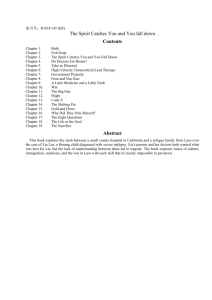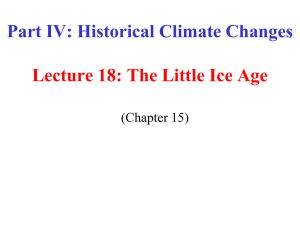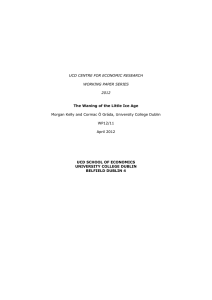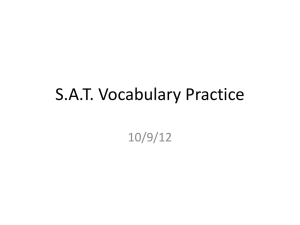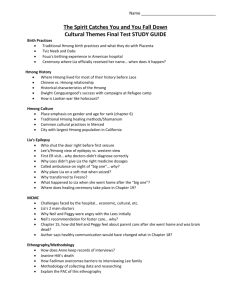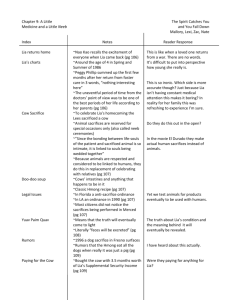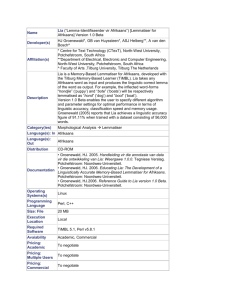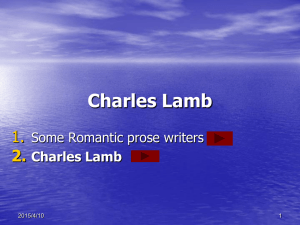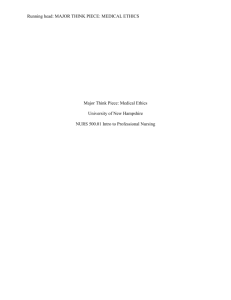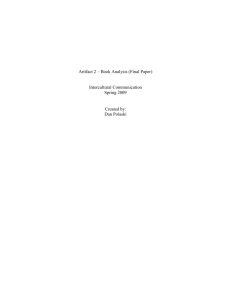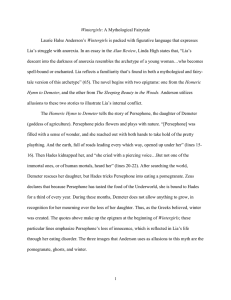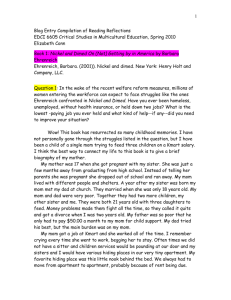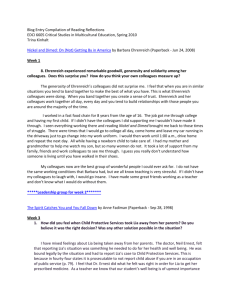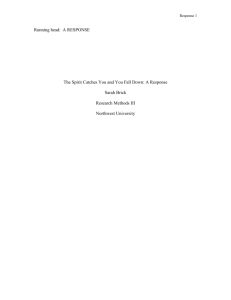Little Ice Age
advertisement
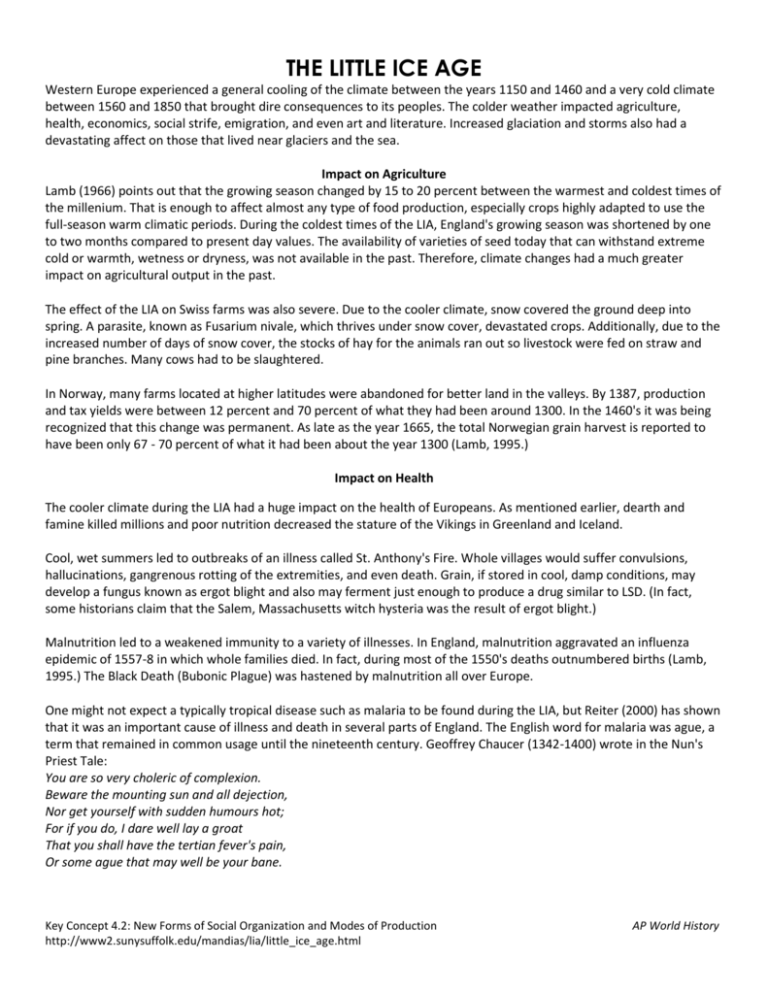
THE LITTLE ICE AGE Western Europe experienced a general cooling of the climate between the years 1150 and 1460 and a very cold climate between 1560 and 1850 that brought dire consequences to its peoples. The colder weather impacted agriculture, health, economics, social strife, emigration, and even art and literature. Increased glaciation and storms also had a devastating affect on those that lived near glaciers and the sea. Impact on Agriculture Lamb (1966) points out that the growing season changed by 15 to 20 percent between the warmest and coldest times of the millenium. That is enough to affect almost any type of food production, especially crops highly adapted to use the full-season warm climatic periods. During the coldest times of the LIA, England's growing season was shortened by one to two months compared to present day values. The availability of varieties of seed today that can withstand extreme cold or warmth, wetness or dryness, was not available in the past. Therefore, climate changes had a much greater impact on agricultural output in the past. The effect of the LIA on Swiss farms was also severe. Due to the cooler climate, snow covered the ground deep into spring. A parasite, known as Fusarium nivale, which thrives under snow cover, devastated crops. Additionally, due to the increased number of days of snow cover, the stocks of hay for the animals ran out so livestock were fed on straw and pine branches. Many cows had to be slaughtered. In Norway, many farms located at higher latitudes were abandoned for better land in the valleys. By 1387, production and tax yields were between 12 percent and 70 percent of what they had been around 1300. In the 1460's it was being recognized that this change was permanent. As late as the year 1665, the total Norwegian grain harvest is reported to have been only 67 - 70 percent of what it had been about the year 1300 (Lamb, 1995.) Impact on Health The cooler climate during the LIA had a huge impact on the health of Europeans. As mentioned earlier, dearth and famine killed millions and poor nutrition decreased the stature of the Vikings in Greenland and Iceland. Cool, wet summers led to outbreaks of an illness called St. Anthony's Fire. Whole villages would suffer convulsions, hallucinations, gangrenous rotting of the extremities, and even death. Grain, if stored in cool, damp conditions, may develop a fungus known as ergot blight and also may ferment just enough to produce a drug similar to LSD. (In fact, some historians claim that the Salem, Massachusetts witch hysteria was the result of ergot blight.) Malnutrition led to a weakened immunity to a variety of illnesses. In England, malnutrition aggravated an influenza epidemic of 1557-8 in which whole families died. In fact, during most of the 1550's deaths outnumbered births (Lamb, 1995.) The Black Death (Bubonic Plague) was hastened by malnutrition all over Europe. One might not expect a typically tropical disease such as malaria to be found during the LIA, but Reiter (2000) has shown that it was an important cause of illness and death in several parts of England. The English word for malaria was ague, a term that remained in common usage until the nineteenth century. Geoffrey Chaucer (1342-1400) wrote in the Nun's Priest Tale: You are so very choleric of complexion. Beware the mounting sun and all dejection, Nor get yourself with sudden humours hot; For if you do, I dare well lay a groat That you shall have the tertian fever's pain, Or some ague that may well be your bane. Key Concept 4.2: New Forms of Social Organization and Modes of Production http://www2.sunysuffolk.edu/mandias/lia/little_ice_age.html AP World History In sixteenth century England, many marshlands were notorious for their ague-stricken populations. William Shakespeare (1564-1616) mentioned ague in eight of his plays. Oliver Cromwell (1599-1658) died of ague in September 1658, which was one of the coldest years of the LIA. Five indigenous species of mosquito are capable of transmitting malaria in England where they prefer the brackish water along river estuaries. The anaerobic bacterial flora of saline mud produces a strong sulfur odor that was widely believed to be the cause of agues in salt marsh areas (i.e. Shakespeare's "unwholesome fens.") The term malaria comes from the Italian term "mala aria" meaning "bad air." Impact on Economics In addition to increasing grain prices and lower wine production, there were many examples of economic impact by the dramatic cooling of the climate. Due to famine, storms, and growth of glaciers ,many farmsteads were destroyed, which resulted in less tax revenues collected due to decreased value of the properties (Lamb, 1995.) Cod fishing greatly decreased, especially for the Scottish fisherman, as the cod moved farther south. The cod fishery at the Faeroe Islands began to fail around 1615 and failed altogether for thirty years between 1675 and 1704 (Lamb, 1995.) In the Hohe Tauern mountains of the Austrian Alps, advancing glaciers closed the gold mines of the Archbishop of Salzburg who was one of the wealthiest dukes in the empire. The succession of two or three bad summers where the miners could not rely on work in the mines caused them to find employment elsewhere, which resulted in an abrupt end to the mining operations (Bryson, 1977.) Not all of the economic impact was bad. The fertile fishing grounds of the present day Newfoundland Banks were thought to have been found by fisherman in the late 1400's who were looking for the fish stocks that had deserted their former grounds as the result of the movement of colder waters from the north (Lamb, 1995.) English fisherman benefited by the southern movement of herring normally found in the waters off Norway. This increase in deep-sea fishing helped to build the maritime population and strength of the country (Lamb, 1995.) The failure of crops in Norway between 1680 and 1720 was a prime reason for the great growth of merchant shipping there. Coastal farmers whose crops failed turned to selling their timber and to constructing ships in order to transport these timbers themselves (Lamb, 1995.) Social Unrest Conditions during the LIA led to many cases of social unrest. The winter of 1709 killed many people in France. Conditions were so bad, a priest in Angers, in west-central France, wrote: "The cold began on January 6, 1709, and lasted in all its rigor until the twenty-fourth. The crops that had been sewn were all completely destroyed.... Most of the hens had died of cold, as had the beasts in the stables. When any poultry did survive the cold, their combs were seen to freeze and fall off. Many birds, ducks, partidges, woodcock, and blackbirds died and were found on the roads and on the thick ice and frequent snow. Oaks, ashes, and other valley trees split with cold. Two thirds of the vines died.... No grape harvest was gathered at all in Anjou.... I myself did not get enough wine from my vineyard to fill a nutshell." (Ladurie, 1971) In March the poor rioted in several cities to keep the merchants from selling what little wheat they had left. The winter of 1739-40 was also a bad one. After that there was no spring and only a damp, cool summer which spoiled the wheat harvest. The poor rebelled and the governor of Liège told the rich to "fire into the middle of them. That's the only way to disperse this riffraff, who want nothing but bread and loot." (Ladurie, 1971). Lamb (1995) reports the occurrence of cattle raids on the Lowlanders by Highlanders who were stressed by the deteriorating climate. In 1436, King James I of Scotland was murdered while hunting on the edge of the Highland region near Perth. The clan warfare grew so bad that it was decided that no place north of Edinburgh Castle was safe for the king so Edinburgh became the capital of the country. In England, the effect of starvation and the poor condition of the country encouraged men to enlist during the War of the Roses (1455-1485.) As tillable land was converted to other uses such as sheep rearing, the landlords who organized the conversions became the focus of many hostilities. Key Concept 4.2: New Forms of Social Organization and Modes of Production http://www2.sunysuffolk.edu/mandias/lia/little_ice_age.html AP World History One group in particular suffered from the poor conditions - people thought to be witches (Behringer, 1999.) Weathermaking was thought to be among the traditional abilities of witches and during the late fourteenth and fifteenth centuries many saw a great witch conspiracy. Extensive witch hunts took place during the most severe years of the LIA, as people looked for scapegoats to blame for their suffering. One of history's most notorious quotes might have been due in part to a rare extremely warm period during the LIA. In northern France in 1788, after an unusually bad winter, May, June, and July were excessively hot, which caused the grain to shrivel. On July 13, just at harvest time, a severe hailstorm (which typically occurs when there is very cold air aloft) destroyed what little crops were left. From that bad harvest of 1788 came the bread riots of 1789 which led to Marie Antoinette's alleged remark "Let them eat cake," and the storming of the Bastille. Task: Analyze how the Little Ice Age impacted: The Environment The Economy Society Individuals Key Concept 4.2: New Forms of Social Organization and Modes of Production http://www2.sunysuffolk.edu/mandias/lia/little_ice_age.html AP World History
